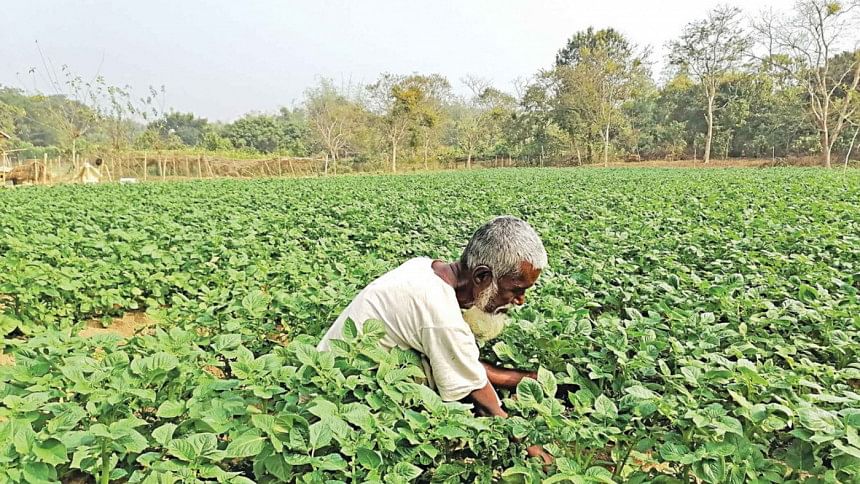Time to find better alternatives to tobacco farming

Tobacco farming was introduced to Bangladesh in the mid-1960s in the Teesta silt of the Rangpur region, where tobacco was cultivated on soil meant for growing food crops. After the Liberation War in 1971, the cultivation of tobacco crops expanded into many more regions of Bangladesh, such as the Chittagong Hill Tracts (CHT) and Kushtia.
According to a survey by the Global Adult Tobacco Survey (GATS) of Bangladesh in 2009, conducted under the World Health Organization (WHO) and Ministry of Health and Family Welfare in Bangladesh, about 35 percent of Bangladeshi adults use tobacco products and/or combustible smokeless products. In meeting this significant demand, Bangladesh has also turned out to be the 12th largest tobacco producing country in the world, according to an article under the International Journal of Environmental Research and Public Health (IJERPH) published in December 2020.
With that in mind, tobacco farming has seen widespread growth in the percentage of land used to grow tobacco crops. The International Organization of Scientific Research (IOSR) Journal of Environmental Science, Toxicology and Food Technology found in 2015 that tobacco farming occurred in more than 120 million acres of arable soil in Bangladesh in the years 2010-11, up from 76 million acres dated a decade before these statistics were found.
Does this expansion in the cultivation of tobacco not come at a price? Does farming tobacco have positive impacts on our farmers? And what effects does tobacco have on our country's environment?
The Occupation Safety and Health Administration (OSHA) emphasises that handling tobacco leads to nicotine exposure, and thus nicotine poisoning for the handlers of tobacco, a condition known as the Green Tobacco Sickness (GTS) that is commonly found in tobacco farmers and handlers, along with skin diseases caused by the pesticides used.
To illustrate the losses faced by farmers in monetary terms, the IJERPH report further states that current tobacco farmers, former tobacco farmers, and non-tobacco farmers incur Tk 2,338.42, Tk 3,151.57 and Tk 2,105.45 respectively in total direct and indirect costs related to health every month; whereas the monthly average incomes of farming households stand at Tk 19,700, Tk 19,589 and Tk 20,562 a month, respectively.
Input costs are also significantly higher for tobacco farmers than farmers who do not cultivate tobacco. The IJERPH report states that the total input costs of current tobacco farmers per yield stands at Tk 47,176 on average, while former tobacco farmers and non-tobacco farmers have input costs of Tk 18,685 and Tk 26,956, respectively. Cultivating tobacco takes a lot of manpower as well. Labour costs per yield for current tobacco farmers stand at Tk 1,36,012 on average, while labour costs for former tobacco farmers and non-tobacco farmers stand at Tk 47,319 BDT and Tk 65,930 per yield, respectively.
As for the environmental effects, there are several WHO reports that point out that tobacco growing uses pesticides, fertilisers, and growth regulators. A huge volume of these chemicals is used in the cultivation of tobacco crops, and this badly damages waterbodies and drinking water sources. A report in The Daily Star from February 16, 2021 focused on how three villages in the Manikchhari upazilla of Khagrachhari gave up tobacco farming with the help of the NGO Integrated Development Foundation (IDF) in order to prevent toxic residue from pesticides used in tobacco farming being washed downstream into the Halda river, polluting the river and significantly harming the brood fish and their egg yields. In fact, it had gotten so bad that no eggs at all were laid by fish in the Halda river in 2016.
Tobacco cultivation also poses other dangers to the environment. Deforestation is one such hazard, where forestland is cleared to make way for farmland, which can cause loss of biodiversity and soil erosion. Tobacco farming also increases carbon dioxide emissions, along with the biggest damage being dealt to the soil fertility as the tobacco crops "deplete soil nutrients by taking up more nitrogen, phosphorus and potassium" than any other major food crops do, according to a WHO report from October 2015.
Yet, farmers tend to choose farming tobacco crops over food crops like paddy or vegetables like eggplants because, according to the British Medical Journal (BMJ), farmers get free tobacco seeds, loans for pesticides and fertilisers, technical support, and guaranteed market facilities where they are promised an even stream of revenue.
However, most farmers are unaware of the fact that, in the long term, it is less profitable to cultivate tobacco plants than it is to grow food crops, with the IJERPH report stating that current tobacco farmers gain about 22 percent profit per acre of land on average while former tobacco farmers and non-tobacco farmers gain 152 percent and 117 percent per acre of land on average, respectively.
In addition to making a better profit from cultivating food crops like paddy and maize, the fertility of farmlands is much easier to preserve because certain crop types can be cycled every year to replenish nutrients back into the farmland soil. Food crops also require much less use of pesticides and chemicals like growth hormones, which means the level of chemicals running off into water sources is significantly lower.
Cultivating food crops, moreover, can help boost the agriculture sector. More food crop cultivation means a greater supply of food for a country that has a population of more than 16 crore people, according to World Bank records in 2018. This creates more value, contributes significantly to the economy's GDP and minimises our need to import food crops.
As a matter of fact, there have been cases where it was possible to convince farmers to switch from farming tobacco crops, as proven by IDF in Manikchhari, as mentioned in the DS news report. All it needed for IDF to change the mindset of an entire village was to raise awareness of the perils of tobacco cultivation to themselves and the environment around them, propose alternative job opportunities for farmers to the relevant authorities, and provide support to the farmers with grants and other necessities.
Shifting farmers away from tobacco farming should not be too difficult for the government either. By educating farmers on the harmful effects of tobacco cultivation and ensuring farmers have steadier and less risky returns on investment through grants and proper buffer stock allocations of agricultural products, we can significantly increase farmers' trust in cultivation of food crops.
Araf Momen Aka is an intern at the Editorial department of The Daily Star.

 For all latest news, follow The Daily Star's Google News channel.
For all latest news, follow The Daily Star's Google News channel. 



Comments